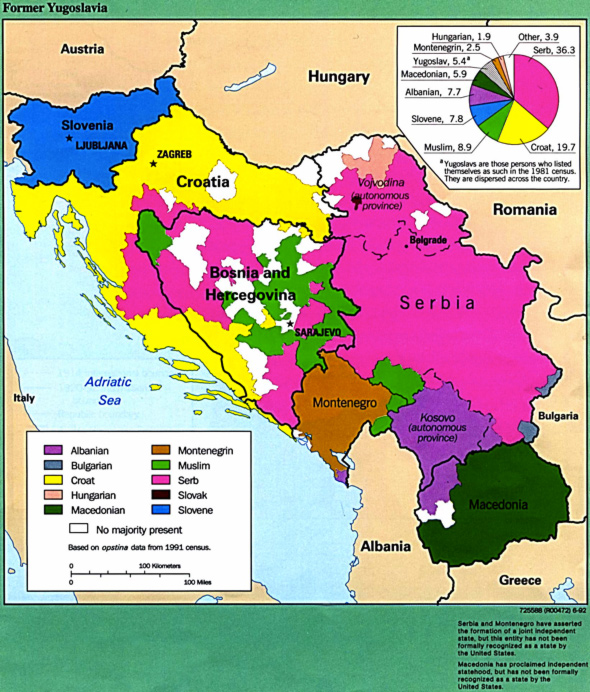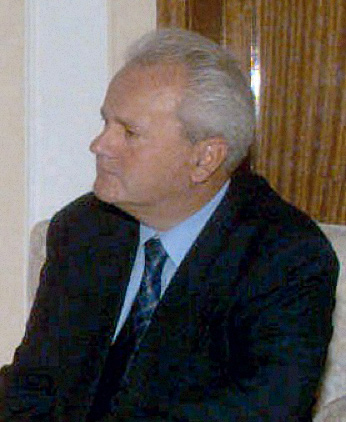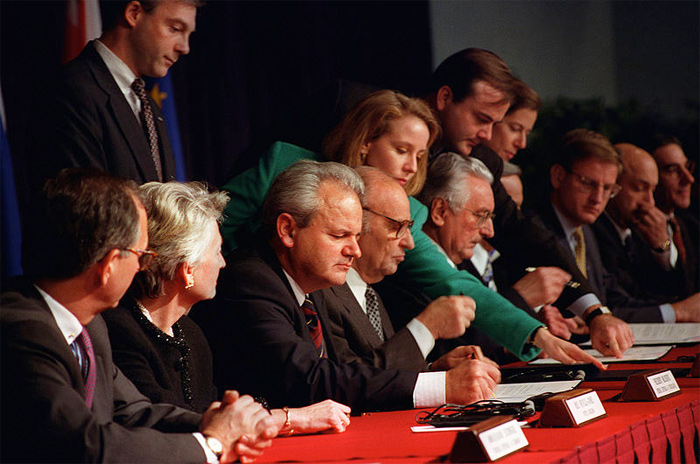The former country of Yugoslavia was created after World War I through the unification of rival ethnic and religious groups on the Balkan peninsula. In 1946, it became a communist country and its totalitarian government attempted to suppress individual ethnic identity. After the Cold War ended, those old tensions resurfaced and the country fractured. This section will use the violent breakup of Yugoslavia as a case study of the dangers of ethnic conflict and how, ultimately, those forces can learn to cooperate.
To begin, examine the map below, which illustrates the changes to the political boundaries on the Balkan Peninsula since 1989.
![]()
In 1991 the country of Yugoslavia, began to break up and separate along ethnic lines. The countries of Slovenia, Croatia, and the Republic of Macedonia all declared their independence in 1991. Bosnia and Herzegovina declared its independence (with its own constitution) in 1992.
The conflict that arose from these political changes were based in the ethnic separation of Yugoslavia. Each separate entity wanted to create their own country. Analyze the ethnic map of the Former Yugoslavia map below and answer the questions that follow:

Source: Yugoslavia ethnic map, Wikimedia



Answer the next question in your notes.

Source: Slobodan Milosevic, Wikimedia
This is a photo of Serbian President Slobodan Milosevic, 1997-2000.
After Bosnia's announcement of separation, the move was opposed by Serb representatives, who had voted in favor of remaining in Yugoslavia. Bosnian Serbs, supported by neighboring Serbia, responded with armed force in an effort to partition the republic along ethnic lines.
Serbia led various military intervention efforts to unite Serbs in neighboring republics to create a "Greater Serbia." All of these efforts were ultimately unsuccessful. In 1999, massive evictions (this was also known as ethnic cleansing) by Serbs of ethnic Albanians living in the autonomous republic of Kosovo provoked an international response, including the NATO bombing of Serbia and the stationing of NATO and Russian peacekeepers in Kosovo.
Analyze the photos in the slideshow below. They chronicle the capture of one of the men behind the genocide that took place during this time period.
In March 1994, Muslims and Croats in Bosnia signed an agreement creating the Federation of Bosnia and Herzegovina, ending a period of Muslim-Croat conflict. The conflict with the Bosnian Serbs continued through most of 1995. Many atrocities were committed, including acts of genocide committed by members of the Army of Republika Srpska in and around Srebrenica in July 1995, where approximately 8,000 Bosnian Muslim men and boys were killed. The conflict ended with the November 21, 1995 Dayton Peace Agreement, which was formally signed on December 14, 1995 in Paris.

Source: Dayton agreement, Wikipedia
[This is a photo of President Slobodan Milosevic of the Federal Republic of Yugoslavia, President Alija Izetbegovic of the Republic of Bosnia and Herzegovina, and President Franjo Tudjman of the Republic of Croatia at the Dayton Peace Accords]
General Framework for Dayton Peace Agreement
—Summary provided by U.S. Department of State
- Bosnia and Herzegovina, Croatia, and the Federal Republic of Yugoslavia (FRY) agree to fully respect the sovereign equality of one another and to settle disputes by peaceful means;
- The FRY and Bosnia and Herzegovina recognize each other and agree to discuss further aspects of their mutual recognition;
- The parties agree to fully respect and promote fulfillment of the commitments made in the various annexes, and they obligate themselves to respect human rights and the rights of refugees and displaced persons; and
- The parties agree to cooperate fully with all entities, including those authorized by the United Nations Security Council, in implementing the peace settlement and investigating and prosecuting war crimes and other violations of international humanitarian law.
Complete the following activity in your notes: